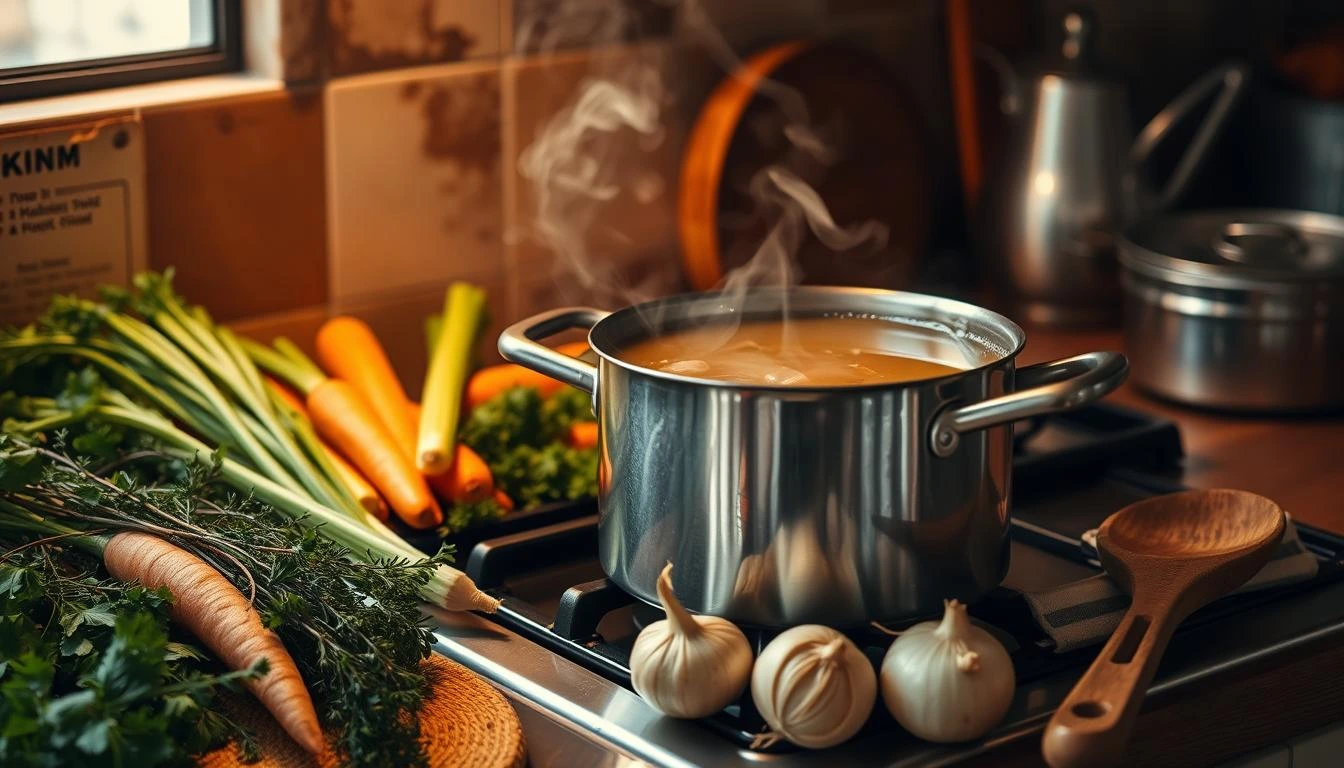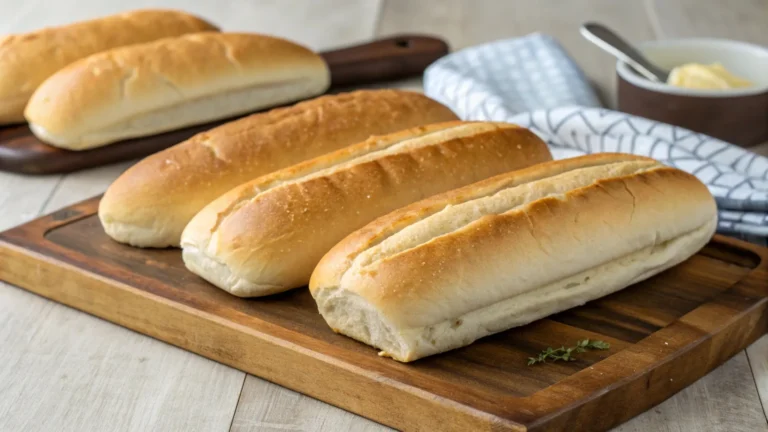How to Make Homemade Chicken Broth

Homemade chicken broth is a versatile and flavorful base for soups, sauces, and various recipes. It starts with a whole raw chicken or chicken pieces, combined with vegetables and herbs. The process yields both delicious broth and tender cooked chicken.
This homemade version is superior to store-bought alternatives, offering richer flavor and nutritional benefits. The recipe typically produces about 8 cups (2 quarts) of broth and 4 cups of cooked chicken.

Table of Contents
Understanding the Basics of Chicken Broth
Chicken broth is a key ingredient in cooking, with a long history. It’s often confused with chicken stock, but they’re different. Broth includes chicken meat, bones, and veggies, while stock is just bones and cartilage.
Difference Between Broth and Stock
Chicken broth has chicken meat, mirepoix, herbs, and spices. This makes it more flavorful. Chicken stock, on the other hand, is just bones. It’s thicker and more gelatinous because of the collagen from the bones.
Benefits of Making Broth at Home
Homemade chicken broth has many benefits. You can choose the ingredients and control the flavor. It’s also cheaper than buying it pre-made. Plus, you can make it with fresh, high-quality ingredients.
Key Characteristics of Quality Broth
Good chicken broth is clear, golden, and savory. It’s slightly gelatinous when cold. It should smell like chicken, with hints of herbs and spices. Making broth this way shows you care about quality.
“The secret to a great chicken broth lies in the quality of the ingredients and the patience to let it simmer until it reaches that perfect balance of flavor and texture.”
Knowing about chicken broth and stock can open up new cooking possibilities. With the right ingredients and techniques, you can make amazing homemade chicken broth. It will take your cooking to the next level.
Essential Ingredients for Homemade Chicken Broth
To make a tasty, high-quality chicken broth at home, you need a few key ingredients. Start with a whole chicken, about 4-5 pounds, or similar bone-in, skin-on pieces. These add flavor and make the broth thick and satisfying.
Next, add onions, carrots, and celery for a sweet and savory taste. Garlic, parsley, thyme, and bay leaves add depth. Don’t forget whole black peppercorns and a bit of salt to enhance the flavor.
While the basic ingredients are great, you can also try adding leeks or mushrooms for different tastes. Using the freshest ingredients makes your homemade chicken broth both delicious and healthy.
| Ingredient | Amount |
|---|---|
| Whole Chicken or Bone-in, Skin-on Chicken Pieces | 4-5 pounds |
| Onions | 3 medium |
| Carrots | 4 ribs |
| Celery | 4 ribs |
| Garlic Cloves | 4 small |
| Parsley Stems | 1 bunch |
| Thyme | 2 sprigs |
| Bay Leaves | 2 leaves |
| Whole Black Peppercorns | 10-12 |
| Kosher Salt | to taste |
With these chicken broth ingredients and the right cooking methods, you get a rich, tasty broth. It’s perfect for soups, stews, sauces, and risottos.
Selecting the Right Chicken Parts
Choosing the right chicken parts is key for a tasty homemade chicken broth. Bone-in, skin-on parts like thighs, drumsticks, or a whole chicken are best. They offer deep flavor, thanks to the dark meat.
Frozen chicken works too, if thawed right. But remember, freezing can change the broth’s texture and taste. Adding organ meats like heart and gizzard can also enhance the broth’s flavor. But, avoid liver as it can make the broth taste bad.
Best Cuts for Flavorful Broth
- Chicken thighs
- Chicken drumsticks
- Whole chicken
Fresh vs. Frozen Chicken
Fresh chicken is best, but frozen works if thawed correctly. Freezing can affect the broth’s texture and taste.
Using Organ Meats and Bones
Adding organ meats like heart and gizzard can boost flavor. But, skip liver. Bones are essential for a gelatinous texture and rich taste. Mixing different parts makes the broth more balanced.
“Chicken wings are recommended for achieving an ideal balance of flavor and gelatin in homemade chicken stock.”
| Chicken Part | Contribution to Broth |
|---|---|
| Chicken Feet | Contain the most collagen and produce a stock that solidifies when chilled. |
| Chicken Skin | Adding raw chicken skin provides added collagen and nutrients to the stock. |
| Chicken Bones | Roasting chicken bones contributes significantly more flavor than using raw bones. |
Required Kitchen Equipment and Tools
Making delicious homemade chicken broth needs the right broth-making tools. You’ll need a large stock pot or Dutch oven, at least 8 quarts. This big pot lets you make a lot of broth at once. Also, a fine-mesh strainer or cheesecloth is key for straining the broth and getting rid of solids.
A big slotted spoon helps you take out chicken, veggies, and solids from the pot. A skimmer tool is great for removing foam and impurities that come up while simmering. For easier herb and spice removal, use a sachet or tea ball.
For storing your broth, have mason jars or other freezer-safe containers ready. These keep your broth fresh for later. Also, a sharp knife and sturdy cutting board are must-haves for chopping veggies.
| Essential Equipment | Recommended Capacity/Size |
|---|---|
| Stock Pot or Dutch Oven | At least 8 quarts |
| Fine-Mesh Strainer or Cheesecloth | – |
| Large Slotted Spoon | – |
| Skimmer Tool | – |
| Sachet or Tea Ball | – |
| Storage Containers (Mason Jars, Freezer-Safe) | Variety of sizes |
| Cutting Knife and Board | – |
With these broth-making tools, you’re set to make tasty, healthy homemade chicken broth at home.
Step-by-Step Guide to Perfect Homemade Chicken Broth
Homemade chicken broth is a must-have in the kitchen. It tastes better and is healthier than store-bought. Here’s how to make the perfect chicken broth:
Preparation Steps
- Put your chicken parts, like a carcass, wings, and bones, in a big pot. Fill it with cold water, making sure the chicken is covered.
- Heat the mix until it boils, then lower the heat. Skim off any foam that comes up.
- Add your veggies, like onions, carrots, and celery, and herbs like thyme, parsley, and bay leaves. Season with salt and peppercorns.
Cooking Process
Now, it’s time to simmer your chicken broth recipe. Simmer it on low heat for about 3 hours. This lets the flavors mix and the broth get its rich taste. Take out any chicken breasts after an hour to keep them moist.
Straining and Storing
After simmering, strain the broth. Use a fine-mesh sieve or cheesecloth to separate the liquid from the solids. This makes your broth clear and free of impurities.
Let the broth cool, then refrigerate it overnight. The next day, you’ll see fat on top. Remove this fat for a cleaner broth.
Put the cooled broth in airtight containers or freezer bags. It keeps in the fridge for 4 days or in the freezer for 3 months. This way, you always have homemade broth ready.
“The secret to a truly exceptional chicken broth lies in the slow, gentle simmering process. Patience and attention to detail are key to unlocking the full depth of flavor.”
Adding Vegetables and Aromatics
Boosting your homemade chicken broth’s flavor is simple with the right veggies and aromatics. Onions, carrots, and celery add depth and nutrients. Garlic, parsley, thyme, and bay leaves bring unique flavors.
For a richer taste, try leeks, mushrooms, or herbs like oregano. Fresh veggies give cleaner flavors. Use a sachet or cheesecloth to make removing aromatics easy.
Chop veggies roughly to release more oils and flavors. Mix and match to find your favorite flavors.
| Ingredient | Quantity | Purpose |
|---|---|---|
| Onions | 1 medium, diced | Adds depth and sweetness |
| Carrots | 2 medium, diced | Provides subtle sweetness and color |
| Celery | 2 stalks, diced | Contributes earthy, savory notes |
| Garlic | 3 cloves, minced | Enhances overall flavor profile |
| Parsley | 1 bunch, stems tied | Imparts fresh, herbal notes |
| Thyme | 3-4 sprigs | Lends a warm, earthy aroma |
| Bay leaves | 2-3 leaves | Provides a subtle, slightly sweet flavor |
Creating a tasty broth means trying out different vegetables for broth, aromatics, and flavor enhancers. Find the mix that you love.

Seasoning and Flavor Enhancement Techniques
Making a tasty homemade chicken broth is more than just boiling ingredients. You need to think about seasoning and how to make it even better. Start with salt, black peppercorns, and bay leaves. These basics are the foundation of your broth.
Traditional Spice Combinations
Many chefs love using herbs like parsley, thyme, and rosemary. They add depth and complexity. Garlic also brings a savory taste. For warmth and color, add a bit of turmeric, which is good for you too.
To make it easy to remove, tie herbs in a bundle or use a sachet. After straining, taste and adjust the seasoning. The goal is to enhance the chicken flavor, not hide it.
Herb Selection Guide
- Parsley: Brightens the broth with its fresh, grassy notes.
- Thyme: Adds earthy, slightly minty undertones.
- Rosemary: Lends a woodsy, pine-like aroma.
- Garlic: Provides a savory, pungent depth of flavor.
- Turmeric: Imparts a vibrant golden hue and subtle warmth.
Try different herb combinations and spice blends to find your favorite broth seasoning. There are countless ways to flavor your broth.
“The secret to a truly exceptional chicken broth lies in the thoughtful selection and combination of herbs and spices.” – Chef Julia Child
Storage and Preservation Methods
Keeping your homemade chicken broth fresh is key. Here are some ways to store and preserve it:
- Refrigerate cooled broth for up to 4 days. Store it in airtight containers or freezer bags and freeze for up to 3 months.
Make sure to leave 1/2-inch space for expansion. - Make sure to label the containers with the date and contents to keep track of their freshness.
- To extend the shelf life, pressure can the broth following proper USDA canning procedures. Canned broth can last up to a year when stored properly.
- Freeze the broth in ice cube trays for convenient, portion-sized servings. Then, transfer the cubes to freezer bags. Defrost frozen broth by placing it in the refrigerator overnight before using.
- Adding a splash of cider vinegar while cooking the broth helps extract more gelatin. This results in a thicker, more nutrient-dense final product.
Drying homemade chicken broth using a dehydrator is another great way to concentrate its flavor. It’s perfect for camping trips or travel. The dried broth can be reconstituted in a 1:4 ratio with hot water and used in various recipes.
| Storage Method | Shelf Life |
|---|---|
| Refrigerator | Up to 4 days |
| Freezer | Up to 3 months |
| Pressure Canned | Up to 1 year |
By following these storage and preservation techniques, you can enjoy the benefits of your homemade chicken broth long after the initial cooking process.

Common Mistakes to Avoid
Making the perfect homemade chicken broth needs careful attention. Steer clear of these common mistakes to get a delicious, tasty broth.
Temperature Control Issues
Don’t let your broth boil. Keep it at a gentle simmer between 195 to 211 degrees Fahrenheit. This stops it from getting cloudy and tasting bad.
A big pot, like an 8-quart one, can make 8 to 12 servings. A 12-quart pot is better for making more or freezing it.
Seasoning Errors
Don’t add too much seasoning at first. It’s better to adjust the flavors after straining. This way, the seasonings won’t get too strong.
Use classic seasonings like parsley, bay leaves, thyme, and peppercorns. They really bring out the chicken flavor.
Storage Problems
Pay attention to how you store it. Using too much water can make it taste weak. Don’t throw away the fat right away; it makes the broth richer.
Let the broth cool down before putting it in the fridge or freezer. This stops bacteria from growing. Don’t store it in the fridge door because of temperature changes. When freezing, leave some space in glass containers to avoid them breaking.
By avoiding these broth-making mistakes, overcooking broth, and broth storage errors, you can make a chicken broth that’s both tasty and healthy.
Creative Ways to Use Your Chicken Broth
Make your cooking better with homemade chicken broth. It’s not just for drinking. It can make many dishes taste great. Try out chicken broth recipes, cooking with broth, and broth-based dishes to impress your taste buds.
Begin by using it in soups and stews. It makes chicken noodle or vegetable soup richer. Cook rice in broth for a flavorful risotto. Or, poach chicken breasts for moist meat.
Chicken broth is also great for cooking grains like quinoa or barley. It makes meats and veggies tender and tasty. Mix it into sauces for a smooth, savory texture. Even use it to poach fish or shrimp.
Chicken broth can make comfort foods like mashed potatoes, stuffing, and dumplings better. Drink it when you’re sick, or use it for a healthy soup.
With homemade chicken broth, you can explore endless recipes. It adds flavor to your meals. Get creative and enjoy the taste it brings.
| Dish | Broth Usage | Key Benefits |
|---|---|---|
| Chicken Noodle Soup | Base for the soup | Adds richness and depth of flavor |
| Risotto | Cooking liquid for rice | Infuses each grain with savory goodness |
| Poached Chicken | Poaching liquid | Keeps the chicken moist and tender |
| Mashed Potatoes | Substitute for milk or cream | Enhances creaminess and flavor |
| Dumplings | Cooking liquid | Imparts a richer, more savory taste |
Be creative with your chicken broth. Try different ways to use it. It’s a versatile ingredient that can make your meals special. Let it become a key part of your cooking.
Conclusion
Homemade chicken broth is an essential staple in every kitchen. It tastes better and is healthier than store-bought. Making it at home is simple, requiring only a few ingredients and easy steps.
By making your own broth, you can always have it ready for your recipes. You can also try different ingredients to make it your own. Learning to make broth will make you a better cook and improve many dishes.
Making your own chicken broth has many advantages. It tastes richer and you can choose what goes into it. This way, you get a broth that’s not only delicious but also good for you.
It’s great for both experienced cooks and beginners. Adding homemade broth to your cooking can make a big difference. It’s a key kitchen essential that can enhance many dishes, from soups to sauces.
Try making your own chicken broth and see how it changes your cooking. It’s a simple way to add flavor and health to your meals. It’s a fundamental culinary staple that opens up new possibilities in the kitchen.
FAQ
What is the difference between chicken broth and chicken stock?
Chicken broth has both bones and meat. Stock only has bones. Making your own broth at home gives you better taste, lets you pick what goes in, and saves money compared to store-bought.
What are the benefits of making chicken broth at home?
Homemade broth tastes richer and is healthier. You can control the ingredients and how much salt is in it. It’s full of nutrients and great for many recipes or just drinking.
What are the key characteristics of quality chicken broth?
Good broth looks clear, tastes rich, and turns gelatinous when cold. Making it at home helps you get these qualities right.
What are the essential ingredients for homemade chicken broth?
You need a whole chicken or bone-in, skin-on pieces, onions, carrots, celery, garlic, parsley stems, thyme, bay leaves, black peppercorns, and salt.
What are the best cuts of chicken for making flavorful broth?
Use bone-in, skin-on chicken parts like thighs, drumsticks, or a whole chicken. Dark meat adds more flavor than white meat.
What kitchen equipment is needed to make chicken broth?
You’ll need a big stockpot or Dutch oven, a strainer or cheesecloth, a slotted spoon, a skimmer, and maybe a sachet or tea ball for herbs and spices.
What is the proper process for making homemade chicken broth?
Start by putting the chicken and cold water in a pot. Boil, then lower the heat and simmer with veggies and seasonings for 1-5 hours. Strain, cool, and store it.
What vegetables and aromatics can be used to enhance the flavor of chicken broth?
Use onions, carrots, and celery for veggies. Garlic, parsley, thyme, and bay leaves are good aromatics. Some recipes add leeks, mushrooms, or oregano too.
What are the best seasoning techniques for chicken broth?
Use salt, black peppercorns, and bay leaves for flavor. Parsley, thyme, and sometimes rosemary are also good. Garlic adds depth, and a bit of turmeric can enhance color and health benefits.
How should homemade chicken broth be stored for optimal shelf life?
Cool broth and refrigerate for up to 4 days or freeze in airtight containers or bags for 3 months. Label well and leave space for expansion when freezing.
What are some common mistakes to avoid when making chicken broth?
Don’t boil the broth, over-season, or use too much water. Don’t throw away the fat right away. Cool before refrigerating and avoid the fridge door to prevent problems.
How can homemade chicken broth be used in the kitchen?
Use it as a base for soups, stews, and sauces. It’s great for cooking grains, deglazing pans, making gravy, or enhancing mashed potatoes. It’s also good for poaching chicken or fish, making light pasta sauces, and as a warm drink.






